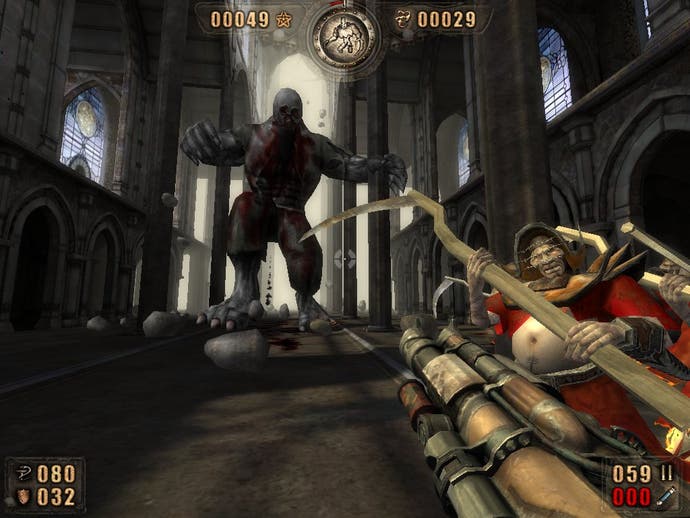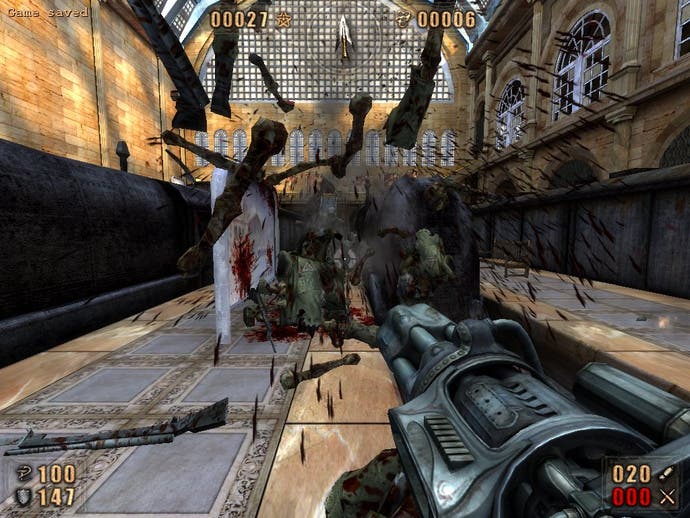Retrospective: Painkiller
Before the Bulletstorm.
Much as I'm fond of its devotion to the old-school, however, I'm not immune to the game's failings. As will no doubt be underlined in the comments thread below, when you stopped taking Painkiller in small doses it got repetitive. Beautiful as they are, levels outstay their welcome. As a relaxing 20-minute break from the daily grind Painkiller was a triumph, as a game you played in long sessions it could eventually feel a mite purgatorial itself.
Replayed in the modern day, when you're not automatically dazzled by the ragdolls and fizz-bang physics, this is an issue that's ever more of a problem. The notion that enemy corpses dissolve into flashing green souls that will eventually turn you into a monochrome-vision heat-hunting death demon is fine in theory, but it slows the game down no end while you're doing laps through the guts of the deceased to harvest them.
So why devote the Eurogamer retro section to Painkiller? Well, simply because when you replay it you can't help but think how well it bodes for Bulletstorm. Painkiller was rough, ready and old-fashioned in its outlook, but it was also book-ended by some very forward-looking traits.

Take, for example, the Black Tarot cards that you can unlock through certain basic tasks in each level and then open up various abilities that you can swap round and take into the fray - essentially the achievement and perk model that is now central to so many shooters released today. Epic didn't just team up with People Can Fly on a whim, they're a studio with great deal of original thought and an unparalleled imagination.
Painkiller pulled off the remarkable trick of cut-and-pasting an insane creative vision out of its designers and into the game's framework. It plays like a game where anything goes, and usually does. Take for example the final level, at the very bottom of the Pit. The actual confrontation with Lucifer is a bit dodgy, yet the level that surrounds it is mind-boggling.
It's essentially a freeze-frame level of warfare through the ages - if you ignore the similarly anti-climactic ghost enemies. The frozen-in-time scenery is special, strange and haunting. At first medieval arrows hang in the air and the faint sound of ancient battle can be heard, then you're in WW1 and looking the precise moment in time that smashed bricks and mortar are exploding from sides of trenches.

Later on an upended warship on an unmoving, rippled sea is captured at its most vertical moment before it slowly plunges into the water below. Finally, looming over the entire level, is a nuclear mushroom cloud frozen in time. As hellscapes go, it's an exceptional one.
So, six years on has People Can Fly abandoned Painkiller? I don't think so, not entirely. Bulletstorm takes place in on an abandoned tourist planet: a heavenly paradise gone wrong. Thematically, at least, it's on the other side of the Painkiller coin - just with more Epic-y space marines and fewer awful cut-scenes starring a recently deceased widower.
The whole set-up allows for the same wild divergences in scenery and fantastically imaginative enemy design. I'm quietly confident that Bulletstorm will be the best shooter of next year, and it's the remaining splinters from the stake that Painkiller fired through my face in 2004 that have me convinced. Roll on next February.








